Basque vs English Community Comparison
COMPARE
Basque
English
Social Comparison
Social Comparison
Basques
English
6,979
SOCIAL INDEX
67.3/ 100
SOCIAL RATING
133rd/ 347
SOCIAL RANK
6,730
SOCIAL INDEX
64.8/ 100
SOCIAL RATING
146th/ 347
SOCIAL RANK
English Integration in Basque Communities
The statistical analysis conducted on geographies consisting of 165,636,030 people shows a poor negative correlation between the proportion of English within Basque communities in the United States with a correlation coefficient (R) of -0.194. On average, for every 1% (one percent) increase in Basques within a typical geography, there is a decrease of 0.228% in English. To illustrate, in a geography comprising of 100,000 individuals, a rise of 1,000 Basques corresponds to a decrease of 228.0 English.
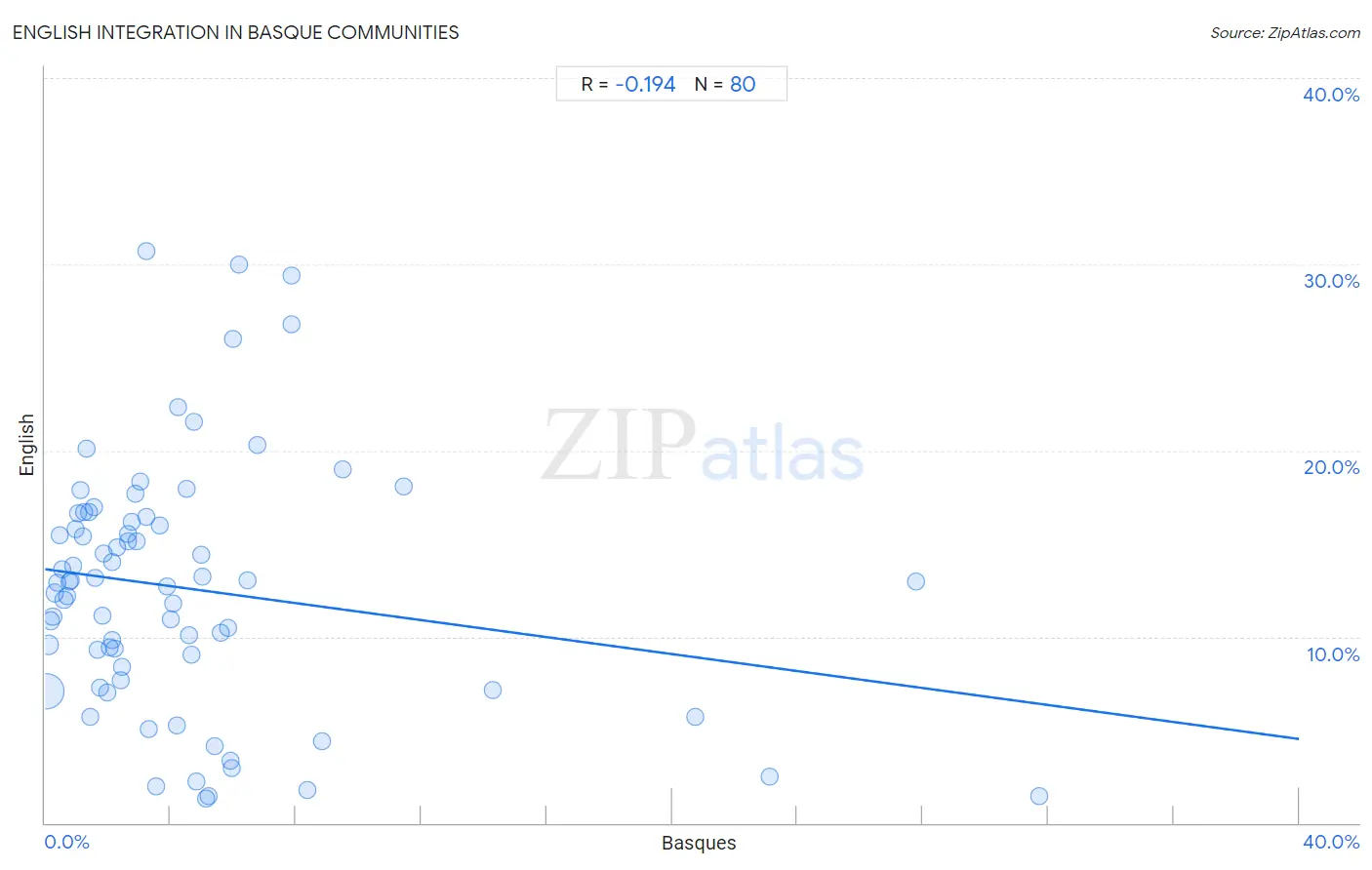
Basque vs English Income
When considering income, the most significant differences between Basque and English communities in the United States are seen in per capita income ($45,086 compared to $43,982, a difference of 2.5%), median household income ($87,001 compared to $84,915, a difference of 2.5%), and householder income ages 25 - 44 years ($96,709 compared to $94,429, a difference of 2.4%). Conversely, both communities are more comparable in terms of median earnings ($46,399 compared to $46,334, a difference of 0.14%), median female earnings ($38,352 compared to $38,196, a difference of 0.41%), and median male earnings ($55,370 compared to $55,747, a difference of 0.68%).

| Income Metric | Basque | English |
| Per Capita Income | Excellent $45,086 | Average $43,982 |
| Median Family Income | Good $104,760 | Good $103,684 |
| Median Household Income | Good $87,001 | Average $84,915 |
| Median Earnings | Average $46,399 | Average $46,334 |
| Median Male Earnings | Good $55,370 | Good $55,747 |
| Median Female Earnings | Tragic $38,352 | Tragic $38,196 |
| Householder Age | Under 25 years | Fair $51,818 | Tragic $50,805 |
| Householder Age | 25 - 44 years | Good $96,709 | Average $94,429 |
| Householder Age | 45 - 64 years | Excellent $103,387 | Good $102,021 |
| Householder Age | Over 65 years | Excellent $62,653 | Good $61,487 |
| Wage/Income Gap | Tragic 28.8% | Tragic 29.5% |
Basque vs English Poverty
When considering poverty, the most significant differences between Basque and English communities in the United States are seen in single father poverty (15.5% compared to 17.8%, a difference of 14.5%), seniors poverty over the age of 65 (10.2% compared to 9.1%, a difference of 12.3%), and seniors poverty over the age of 75 (11.5% compared to 10.4%, a difference of 10.3%). Conversely, both communities are more comparable in terms of child poverty among boys under 16 (15.2% compared to 15.1%, a difference of 0.25%), child poverty under the age of 16 (14.8% compared to 14.9%, a difference of 0.69%), and child poverty among girls under 16 (15.0% compared to 15.3%, a difference of 2.1%).
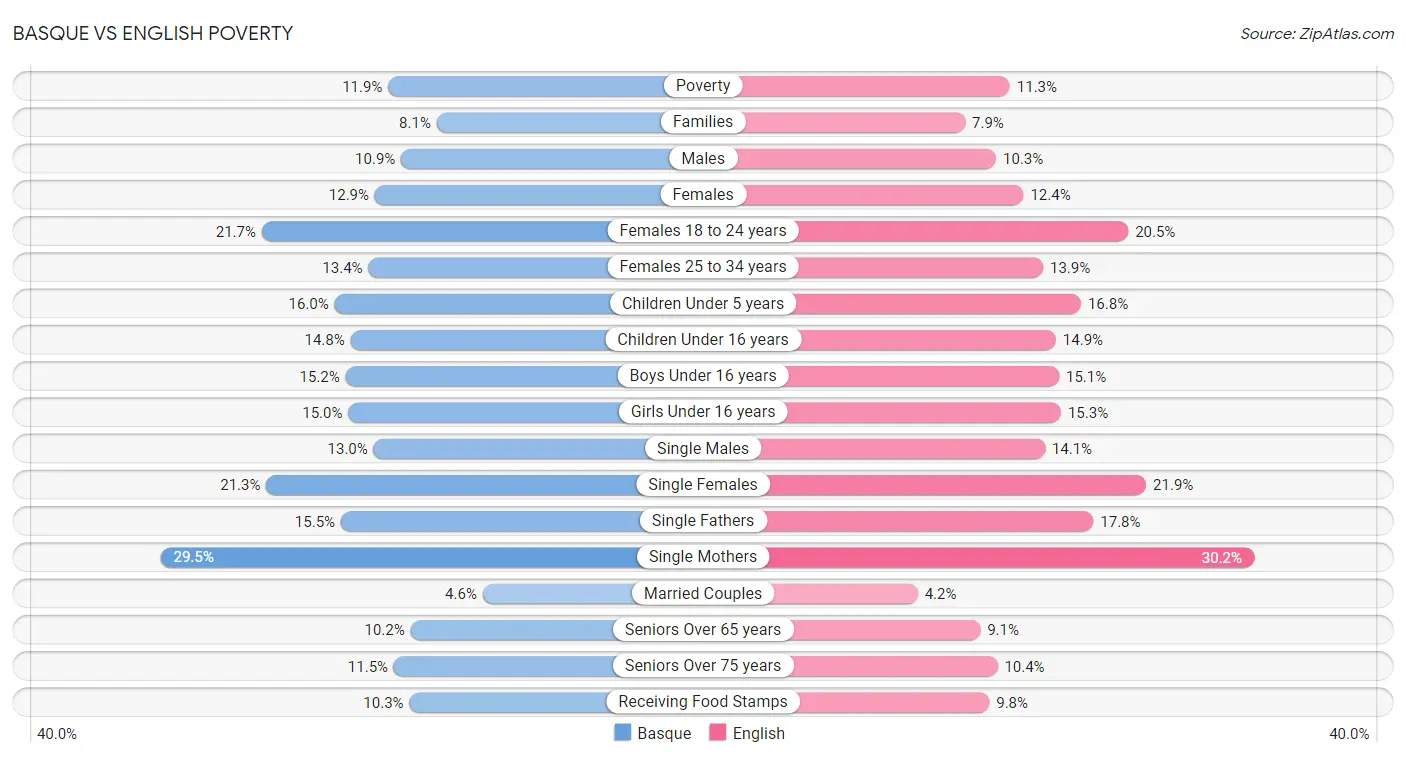
| Poverty Metric | Basque | English |
| Poverty | Excellent 11.9% | Exceptional 11.3% |
| Families | Exceptional 8.1% | Exceptional 7.9% |
| Males | Good 10.9% | Exceptional 10.3% |
| Females | Excellent 12.9% | Exceptional 12.4% |
| Females 18 to 24 years | Tragic 21.7% | Poor 20.5% |
| Females 25 to 34 years | Average 13.4% | Fair 13.9% |
| Children Under 5 years | Exceptional 16.0% | Good 16.8% |
| Children Under 16 years | Exceptional 14.8% | Exceptional 14.9% |
| Boys Under 16 years | Exceptional 15.2% | Exceptional 15.1% |
| Girls Under 16 years | Exceptional 15.0% | Exceptional 15.3% |
| Single Males | Fair 13.0% | Tragic 14.1% |
| Single Females | Fair 21.3% | Tragic 21.9% |
| Single Fathers | Exceptional 15.5% | Tragic 17.8% |
| Single Mothers | Fair 29.5% | Tragic 30.2% |
| Married Couples | Exceptional 4.6% | Exceptional 4.2% |
| Seniors Over 65 years | Exceptional 10.2% | Exceptional 9.1% |
| Seniors Over 75 years | Exceptional 11.5% | Exceptional 10.4% |
| Receiving Food Stamps | Exceptional 10.3% | Exceptional 9.8% |
Basque vs English Unemployment
When considering unemployment, the most significant differences between Basque and English communities in the United States are seen in unemployment among seniors over 75 years (8.1% compared to 10.1%, a difference of 24.1%), unemployment among women with children ages 6 to 17 years (8.2% compared to 9.4%, a difference of 14.3%), and female unemployment (5.1% compared to 4.6%, a difference of 10.3%). Conversely, both communities are more comparable in terms of unemployment among ages 30 to 34 years (5.4% compared to 5.4%, a difference of 0.18%), unemployment among women with children under 6 years (7.8% compared to 8.0%, a difference of 2.4%), and unemployment among ages 25 to 29 years (6.8% compared to 6.6%, a difference of 2.4%).
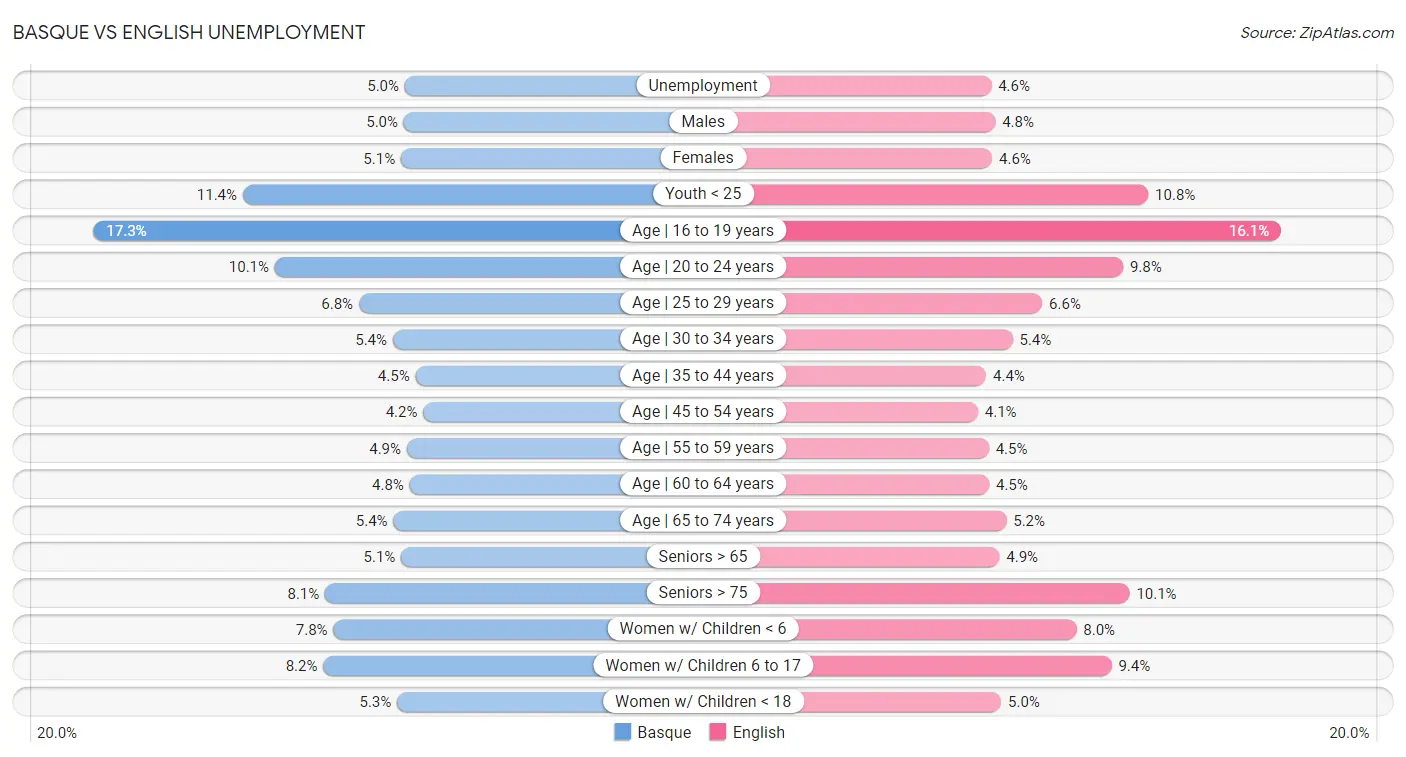
| Unemployment Metric | Basque | English |
| Unemployment | Exceptional 5.0% | Exceptional 4.6% |
| Males | Exceptional 5.0% | Exceptional 4.8% |
| Females | Excellent 5.1% | Exceptional 4.6% |
| Youth < 25 | Excellent 11.4% | Exceptional 10.8% |
| Age | 16 to 19 years | Excellent 17.3% | Exceptional 16.1% |
| Age | 20 to 24 years | Excellent 10.1% | Exceptional 9.8% |
| Age | 25 to 29 years | Fair 6.8% | Average 6.6% |
| Age | 30 to 34 years | Average 5.4% | Average 5.4% |
| Age | 35 to 44 years | Excellent 4.5% | Exceptional 4.4% |
| Age | 45 to 54 years | Exceptional 4.2% | Exceptional 4.1% |
| Age | 55 to 59 years | Fair 4.9% | Exceptional 4.5% |
| Age | 60 to 64 years | Excellent 4.8% | Exceptional 4.5% |
| Age | 65 to 74 years | Fair 5.4% | Exceptional 5.2% |
| Seniors > 65 | Good 5.1% | Exceptional 4.9% |
| Seniors > 75 | Exceptional 8.1% | Tragic 10.1% |
| Women w/ Children < 6 | Fair 7.8% | Tragic 8.0% |
| Women w/ Children 6 to 17 | Exceptional 8.2% | Tragic 9.4% |
| Women w/ Children < 18 | Excellent 5.3% | Exceptional 5.0% |
Basque vs English Labor Participation
When considering labor participation, the most significant differences between Basque and English communities in the United States are seen in in labor force | age 16-19 (39.3% compared to 42.4%, a difference of 7.9%), in labor force | age 20-24 (76.5% compared to 77.6%, a difference of 1.3%), and in labor force | age 25-29 (83.4% compared to 84.5%, a difference of 1.3%). Conversely, both communities are more comparable in terms of in labor force | age 30-34 (84.0% compared to 84.0%, a difference of 0.070%), in labor force | age 20-64 (78.7% compared to 78.8%, a difference of 0.090%), and in labor force | age 45-54 (82.0% compared to 82.2%, a difference of 0.29%).

| Labor Participation Metric | Basque | English |
| In Labor Force | Age > 16 | Tragic 64.2% | Tragic 63.7% |
| In Labor Force | Age 20-64 | Tragic 78.7% | Tragic 78.8% |
| In Labor Force | Age 16-19 | Exceptional 39.3% | Exceptional 42.4% |
| In Labor Force | Age 20-24 | Exceptional 76.5% | Exceptional 77.6% |
| In Labor Force | Age 25-29 | Tragic 83.4% | Fair 84.5% |
| In Labor Force | Age 30-34 | Tragic 84.0% | Tragic 84.0% |
| In Labor Force | Age 35-44 | Tragic 83.6% | Tragic 83.8% |
| In Labor Force | Age 45-54 | Tragic 82.0% | Tragic 82.2% |
Basque vs English Family Structure
When considering family structure, the most significant differences between Basque and English communities in the United States are seen in single father households (2.5% compared to 2.3%, a difference of 8.3%), births to unmarried women (29.7% compared to 31.7%, a difference of 6.8%), and currently married (48.1% compared to 49.7%, a difference of 3.3%). Conversely, both communities are more comparable in terms of divorced or separated (12.6% compared to 12.6%, a difference of 0.070%), single mother households (5.7% compared to 5.8%, a difference of 0.40%), and family households (64.7% compared to 65.1%, a difference of 0.62%).

| Family Structure Metric | Basque | English |
| Family Households | Excellent 64.7% | Exceptional 65.1% |
| Family Households with Children | Good 27.7% | Fair 27.3% |
| Married-couple Households | Exceptional 48.4% | Exceptional 49.6% |
| Average Family Size | Tragic 3.19 | Tragic 3.11 |
| Single Father Households | Tragic 2.5% | Good 2.3% |
| Single Mother Households | Exceptional 5.7% | Exceptional 5.8% |
| Currently Married | Exceptional 48.1% | Exceptional 49.7% |
| Divorced or Separated | Tragic 12.6% | Tragic 12.6% |
| Births to Unmarried Women | Exceptional 29.7% | Average 31.7% |
Basque vs English Vehicle Availability
When considering vehicle availability, the most significant differences between Basque and English communities in the United States are seen in no vehicles in household (7.8% compared to 6.5%, a difference of 19.3%), 4 or more vehicles in household (8.4% compared to 7.6%, a difference of 10.6%), and 3 or more vehicles in household (24.3% compared to 23.1%, a difference of 5.2%). Conversely, both communities are more comparable in terms of 2 or more vehicles in household (61.4% compared to 61.9%, a difference of 0.86%), 1 or more vehicles in household (92.4% compared to 93.8%, a difference of 1.5%), and 3 or more vehicles in household (24.3% compared to 23.1%, a difference of 5.2%).

| Vehicle Availability Metric | Basque | English |
| No Vehicles Available | Exceptional 7.8% | Exceptional 6.5% |
| 1+ Vehicles Available | Exceptional 92.4% | Exceptional 93.8% |
| 2+ Vehicles Available | Exceptional 61.4% | Exceptional 61.9% |
| 3+ Vehicles Available | Exceptional 24.3% | Exceptional 23.1% |
| 4+ Vehicles Available | Exceptional 8.4% | Exceptional 7.6% |
Basque vs English Education Level
When considering education level, the most significant differences between Basque and English communities in the United States are seen in no schooling completed (1.8% compared to 1.4%, a difference of 31.5%), professional degree (4.6% compared to 4.4%, a difference of 5.5%), and high school diploma (89.8% compared to 91.4%, a difference of 1.8%). Conversely, both communities are more comparable in terms of doctorate degree (1.9% compared to 1.9%, a difference of 0.20%), associate's degree (46.5% compared to 46.4%, a difference of 0.21%), and nursery school (98.2% compared to 98.7%, a difference of 0.45%).
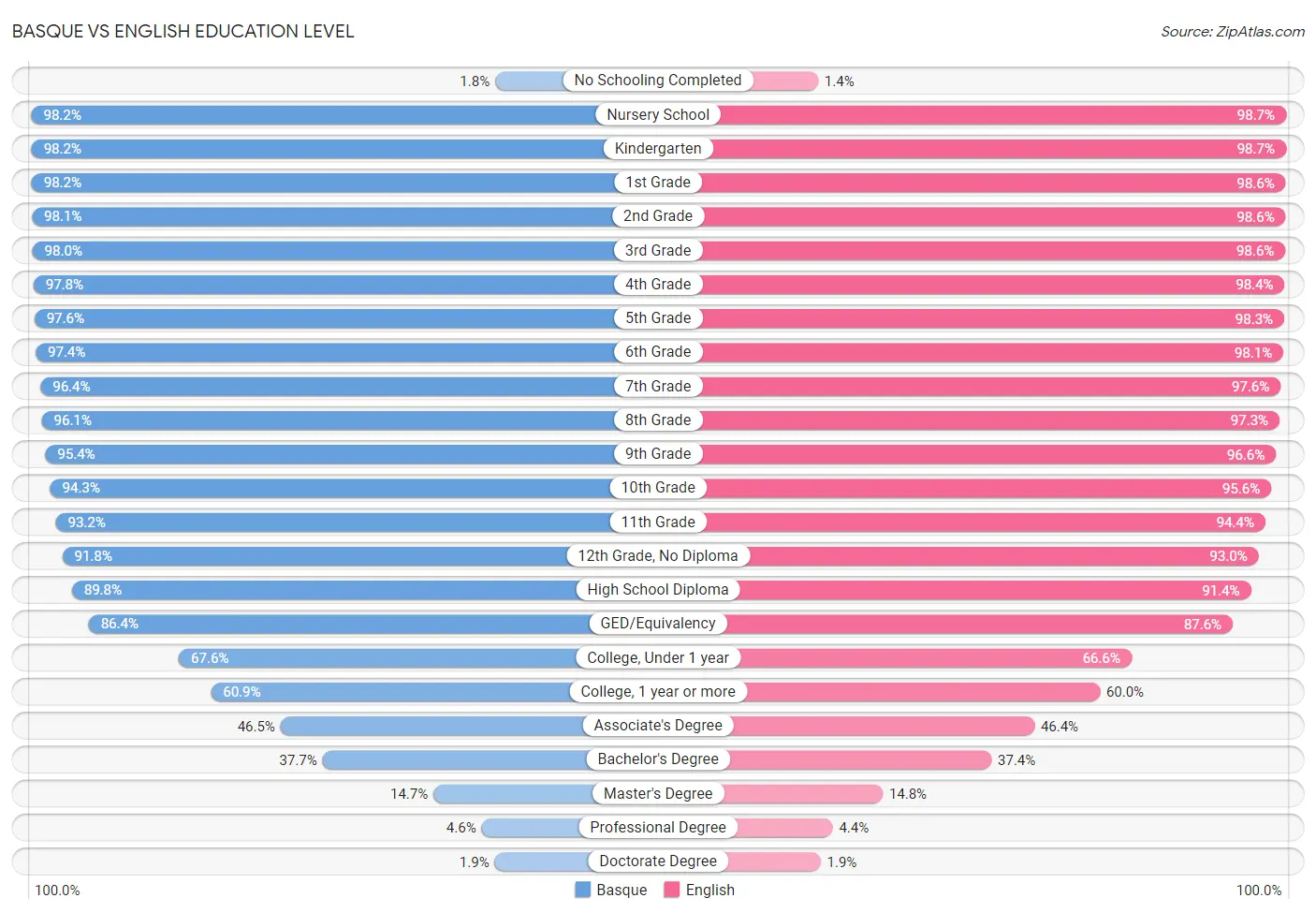
| Education Level Metric | Basque | English |
| No Schooling Completed | Exceptional 1.8% | Exceptional 1.4% |
| Nursery School | Exceptional 98.2% | Exceptional 98.7% |
| Kindergarten | Exceptional 98.2% | Exceptional 98.7% |
| 1st Grade | Exceptional 98.2% | Exceptional 98.6% |
| 2nd Grade | Exceptional 98.1% | Exceptional 98.6% |
| 3rd Grade | Exceptional 98.0% | Exceptional 98.6% |
| 4th Grade | Exceptional 97.8% | Exceptional 98.4% |
| 5th Grade | Exceptional 97.6% | Exceptional 98.3% |
| 6th Grade | Exceptional 97.4% | Exceptional 98.1% |
| 7th Grade | Excellent 96.4% | Exceptional 97.6% |
| 8th Grade | Exceptional 96.1% | Exceptional 97.3% |
| 9th Grade | Exceptional 95.4% | Exceptional 96.6% |
| 10th Grade | Exceptional 94.3% | Exceptional 95.6% |
| 11th Grade | Exceptional 93.2% | Exceptional 94.4% |
| 12th Grade, No Diploma | Exceptional 91.8% | Exceptional 93.0% |
| High School Diploma | Excellent 89.8% | Exceptional 91.4% |
| GED/Equivalency | Good 86.4% | Exceptional 87.6% |
| College, Under 1 year | Exceptional 67.6% | Excellent 66.6% |
| College, 1 year or more | Excellent 60.9% | Good 60.0% |
| Associate's Degree | Average 46.5% | Average 46.4% |
| Bachelor's Degree | Average 37.7% | Fair 37.4% |
| Master's Degree | Fair 14.7% | Average 14.8% |
| Professional Degree | Excellent 4.6% | Average 4.4% |
| Doctorate Degree | Good 1.9% | Good 1.9% |
Basque vs English Disability
When considering disability, the most significant differences between Basque and English communities in the United States are seen in disability age under 5 (1.3% compared to 1.7%, a difference of 24.9%), ambulatory disability (6.1% compared to 6.6%, a difference of 8.3%), and disability age 5 to 17 (5.7% compared to 6.2%, a difference of 7.6%). Conversely, both communities are more comparable in terms of disability age 65 to 74 (23.5% compared to 23.6%, a difference of 0.64%), self-care disability (2.4% compared to 2.5%, a difference of 1.4%), and disability age over 75 (47.6% compared to 46.8%, a difference of 1.7%).
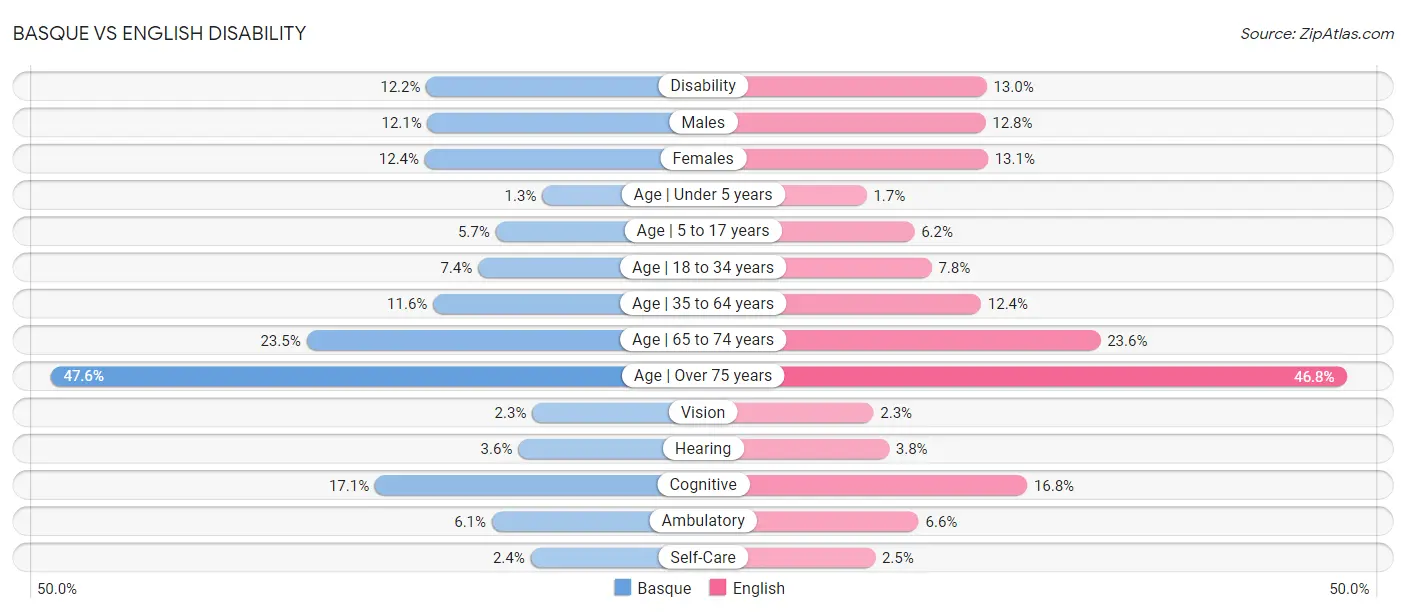
| Disability Metric | Basque | English |
| Disability | Tragic 12.2% | Tragic 13.0% |
| Males | Tragic 12.1% | Tragic 12.8% |
| Females | Poor 12.4% | Tragic 13.1% |
| Age | Under 5 years | Tragic 1.3% | Tragic 1.7% |
| Age | 5 to 17 years | Poor 5.7% | Tragic 6.2% |
| Age | 18 to 34 years | Tragic 7.4% | Tragic 7.8% |
| Age | 35 to 64 years | Poor 11.6% | Tragic 12.4% |
| Age | 65 to 74 years | Fair 23.5% | Fair 23.6% |
| Age | Over 75 years | Fair 47.6% | Excellent 46.8% |
| Vision | Tragic 2.3% | Tragic 2.3% |
| Hearing | Tragic 3.6% | Tragic 3.8% |
| Cognitive | Excellent 17.1% | Exceptional 16.8% |
| Ambulatory | Good 6.1% | Tragic 6.6% |
| Self-Care | Good 2.4% | Average 2.5% |